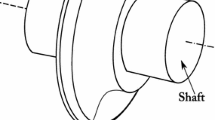Abstract
A methodological approach and specialized program for studying inhomogeneous threedimensional fields of residual stresses in massive bodies are developed based on the mathematical treatment of the experimental information on the displacement distribution of the surface points of the object under study appearing when forming a sequentially deepened disc cut—crack. The efficiency of the procedure for studying the essentially nonuniform distribution of residual stresses over the part depth is shown.
Similar content being viewed by others
References
Lohe, D., Lang, K.-H., and Vohringer, O., Residual stresses and fatigue behavior, in Handbook of Residual Stress and Deformation of Steel, Totten, G., Howes, M., and Unoue, T., Eds., ASM Int., 2002. pp. 27–54.
Matvienko, Yu.G., Modeling and fracture criteria in current problems of strength, survivability and machine safety, J. Mach. Manuf. Reliab., 2014. vol. 43, no. 3, p. 242.
Matvienko, Yu.G., Two-parameter fracture mechanics in contemporary strength problems, J. Mach. Manuf. Reliab., 2013. vol. 42, no. 5, p. 374.
Vajdanatan, A. and Finny, A., Determination of residual stresses from stresses intensity factors measurements, Trans. ASME. Ser. C, 1971. vol. 93, pp. 131–135.
Dveres, M.N. and Fomin, A.V., The way to determine residual stresses, Mashinovedenie, 1985. no. 5, pp. 23–31.
Kuliev, V.D. and Razumovskii, I.A., The way to determine residual stresses in bimetals, Dokl. Akad. Nauk SSSR, 1990. no. 3, pp. 561–565.
Medvedev, M.V. and Razumovskii, I.A., The way to research locally inhomogeneous residual stresses fields by cutting elements, Probl. Mashinostr. Nadezhn. Mash., 1998. no. 5, pp. 86–93.
Razumovsky, L.A., Medvedev, M.V., and Fomin, A.V., Methods for investigations inhomogeneous residual stresses fields, in Handbook of Residual Stress and Deformation of Steel, Totten, G., Howes, M., and Unoue, T., Eds., ASM Int., 2002. pp. 125–138.
Prime, M.B. and Hill, M.R., Uncertainty, model error, and order selection for series-expanded, residual-stress inverse solutions, ASME J. Eng. Mater. Technol., 2006. vol. 128, pp. 175–185.
Cheng, W. and Finnie, I., Residual Stresses Measurements and Slitting Method, Springer, 2007.
Birger, I.A., Ostatochnye napryazheniya (Residual Stresses), Moscow: Mashgiz, 1963.
Razumovskii, I.A. and Khvostov, S.M., The way to research residual stresses in bimetallic cowling for bodies, Probl. Mashinostr. Nadezhn. Mash., 2004. no. 4, pp. 39–44.
Zucarello, B., Optimal calculation step for the evaluation of residual stress by the incremental hole-drilling method, Experim. Mech., 1999. vol. 39, pp. 117–124.
Razumovskii, I.A. and Chernyatin, A.S., An experimental and computational method for investigation of residual stresses in two-layer construction members using hole drilling, J. Mach. Manuf. Reliab., 2011. vol. 40, no. 4, p. 386.
Gloud, G.L., Optical Methods of Engineering Analysis, Cambridge Univ. Press, 1998.
Rasumovsky, I.A., Interference-Optical Methods of Solid Mechanics, Springer, 2011.
Razumovskii, I.A. and Chernyatin, A.S., Methodology and a program for determining stress-deformed state parameters by processing the experimental data, Mashinostr. Inzh. Obraz., 2009. no. 4, pp. 26–32.
Chernyatin, A. and Razumovsky, I., Experimental and computational method for determining parameters of stress-strain state from the data obtainable by interference optical techniques, Proc. EPJ Web of Conf., Poitiers, July 4–9, 2010.
Razumovskii, I.A., The way to determine intensity factors of thermoelastic loadings in cracks in bimetallic elements at volumetric optical models, Mashinovedenie, 1985. no. 2, pp. 70–76.
Makhutov, N.A., Petrova, I.M., Gadolina, I.V., et al., On peculiarities in construction of a modified fatigue curve, J. Mach. Manuf. Reliab., 2010. vol. 39, no. 4, p. 338.
Author information
Authors and Affiliations
Corresponding author
Additional information
Original Russian Text © A.S. Chernyatin, I.A. Razumovskii, 2015, published in Problemy Mashinostroeniya i Nadezhnosti Mashin, 2015, No. 5, pp. 93–102.
About this article
Cite this article
Chernyatin, A.S., Razumovskii, I.A. A sequentially deepened disc cut as an indicator of residual stresses in spatial bodies. J. Mach. Manuf. Reliab. 44, 471–478 (2015). https://doi.org/10.3103/S1052618815050064
Received:
Published:
Issue Date:
DOI: https://doi.org/10.3103/S1052618815050064




